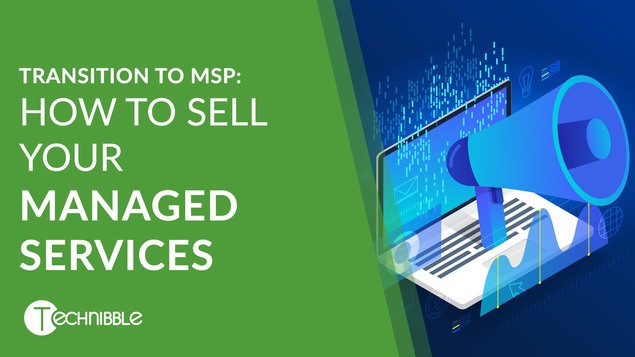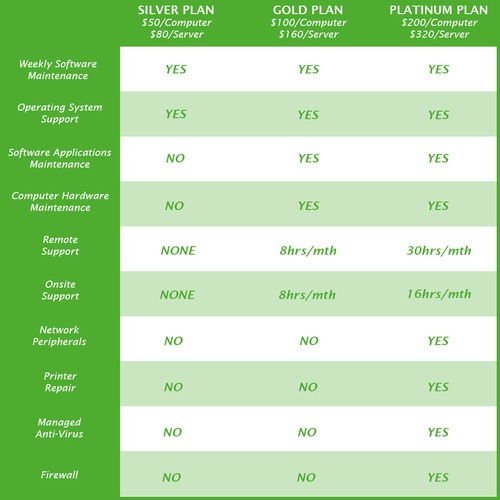- You are here:
- Home »
- Blog »
- Manage Your Computer Business »
- How To Successfully Sell Managed IT Services to Your Clients

How To Successfully Sell Managed IT Services to Your Clients
“If you aim at nothing when selling managed IT services, that’s exactly what you’re going to get”.
For any business venture that you have, preparation is the key. If you have no clear picture of what you want to do, then you will not sound very convincing when you sell managed services to your prospects. Also, you waste your time barking at the wrong tree when the profile of your customers does not match your business goals.
It’s important to get everything together before you go jump into the water and make your first sales call. This may take a bit of your time, but there’s no shortcut. When you’re done piecing the puzzle together, it’s well worth it. And you will be better equipped when you sell managed services to prospects.
Profiling to Sell Managed Services
The first order of the day is to decide what kind of clients you’d want to do business with. Knowing your clients and their pain point is crucial in identifying your business opportunities. On the other hand, it will most likely take a lot of your time and effort to convince a customer who doesn’t give much importance to technology.
If you already have a database for your business users, then that’s a big help. You can run a summary of how much each client spends on repairs for a year in your CRM. Then you can design a three-level set of clients based on their yearly budget for repairs. From this you can see which customers you will be dropping, to save time and effort. You’ll also see which ones are your low-level, mid-level, and high-end clients.
So let’s say, those who spend $2,500 to $4,000 are your low-level clients. Next, those who spend between $4,000 to $7,000 are your mid-levels. And last, those who spend more than the rest will be considered your high-end clients.
For new business users, you can still classify them based on the size of their network. You can conduct a market survey on your prospective clients to get this data.
Let’s say your prospect with 10-15 computers will be your low-level client. Next, 16-30 computers will be your mid-level client. And last, having more than 30 computers will land your prospect on the high-end of the market spectrum. This way, you will have an estimate of how much you could earn based on the number of their computers and servers.
This first step will set the direction of your sales thrust. The more you narrow down your prospects, the greater the chances of selling your managed services. And getting that contract signed!
Your Managed Services Offering

Now that your business targets are in plain sight, the next step is to load up on your ammunition – figuratively speaking. Although you may think that this is insignificant, this too is an important piece of the big picture.
This is where you write down everything that is in your skillset, all the things you can do to support your client. Don’t leave anything out. Write down even the products that you carry. While doing this list, you may want to identify which services you’d want to include for these fees – minimal, optimal, and expensive. Don’t include everything you can do, just add the ones that make sense for a plan. This will help you draft your pricing model, which brings us to our next point.
Selling Managed Services by Pricing Model
Tiered pricing is all around us even though we may be unaware of it. But when you are choosing which service to pay for in sending a package – regular, speedy, or express – that’s tier pricing at work. By using this approach when you sell managed services, your clients can decide which option is best for them and fits their budget.
The most commonly used for business is the three-tier pricing strategy. It usually consists of a basic, advanced, and premium option. Here the basic option is a safe choice, with minimal services. While the advanced option is the optimal amount of service for your clients, and the optimal amount of revenue for you. The last option is the most expensive one but includes all the services that your skill set can provide.
For example, you have three-tier pricing labeled Silver (basic), Gold (advanced), and Platinum (premium). Let’s look at a sample managed services pricing plan to illustrate this.

Of course, this is not an exhaustive list or a complete model. And you need to make sure that your managed services pricing is already in order. This should also work in concert with your SLA. For example, your Platinum package covers both hardware monitoring and replacement. But each incident is deductible from its hours of onsite support. This prevents an all-you-can-eat kind of service, which is bad for your business.
Your Sales Presentation
At this point, there’s no confusion on what kind of clients you’d want to bring into your business. You have your list of services, and you even have your three-tier pricing model. The only missing piece of the puzzle is presenting your managed services to your client. Of course, the best goal is to have your client sign the contract after the meeting.
But before you jump to sell your managed services, it’s best to put yourself in your customer’s shoes. What would be their main concern if they sign up for your managed services? What possible questions can they ask? How would you answer those questions? Looking at the matter from your client’s perspective will help you connect with them better and address issues that are relevant to them.
You may also want to start by meeting with your lower-level clients first. Then after you gain experience you can go for your high-end business users.
Connect with the Decision-Maker

When setting appointments, make sure that you are targeting the right person – the decision-maker. Presenting to a non-decision maker will need you to set another appointment and this is a waste of time. And when you do present to the right person, make sure to highlight the benefits. Use your three-tier pricing table extensively and explain it in detail.
How will it help the company cut costs? Will it improve customer service or reduce risk? Will it give the company a competitive edge because your services provide a capability that is limited for now?
Whatever advantage you would like to point out, make sure to emphasize how your services can make that happen.
True, the hardest part of the meeting is closing the sale. You shouldn’t sound too imposing to your client. You mustn’t sound too casual either like it was just a friendly chat and you’ll get on with your lives after this. Remember, you presented a business proposal.
And one of the tactful ways to ask for a decision from your client is to pose this question:
Do you think what I’m offering can solve your problem?
If your client has an objection, you will have a chance to address it. If your client is sold out on your proposal, then all your efforts are well worth it. Of course, everything boils down to how you go about selling managed IT services to your clients.
As you navigate the ever-evolving landscape of Managed IT services and strive to meet the diverse needs of your clients, consider signing up to the Technibble Marketing Membership. The membership equips you with a wealth of white-label marketing materials, empowering you to effectively communicate the value of your services to clients.
